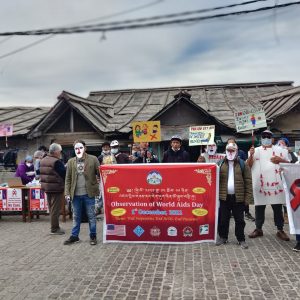
As guided by the World Health Organisation (WHO), World AIDS day was marked across the globe with awareness campaigns on preventative measures and expressions of solidarity with HIV patients on 1 December. The Department of Health, Central Tibetan Administration, also marked the day with the objective of raising awareness and reducing the stigma associated with having the disease in Tibetan schools and settlements.
Since the HIV virus was discovered, it has contracted 79.3 million people in the world till date and has taken the lives of at least 36.3 million. In 2020 alone, 1.5 million new people contracted the virus and 6.8 lack people died from the virus. Currently, at least 37.7 million people are living with AIDS around the world. However, due to increased awareness on the virus and how it is spread, contraction cases are slowly decreasing globally. Between 2010 and 2020, there was 31% decrease in contraction rates. In 2010, there was 2.1 million new cases while in 2021, only.1.5 million new cases were reported. Similarly, in 2021, 1.3 million people died of AIDS while only 6.8 lacks died from AIDS in 2020.
CTA”S Department of Health also offers its assistance and support towards AIDS patients in the Tibetan community. Currently, the Health Department has 53 AIDS patients in its record and it offers all the treatment-related assistance and support to the patients.The Health departments offers free HIV tests in all its affiliated hospitals and clinics. It has also provided training to the nurses and health workers on how to deal with AIDS patients.
The Indian government also provides Anti Retroviral Therapy at free of cost to AIDS patients. The Anti Retroviral Therapy helps stabilise CD4 count in the body. Therefore, those with HIV should avail these benefits and take care of oneself through exercise to keep fit physically and mentally.
Although the Health Department does its best to offer support and assistance to AIDS patients, due to social ostracisation, mental stress and stigmas associated with AIDS, patients seldom come out in the open. They sometimes relocate, quit their jobs, become estranged from their families and loved ones, and succumb to the disease.
Since AIDS cannot be detected from skin tones and external features, one should exercise precaution while having sexual relations. In today’s era of instant connectivity and social media, it is easier than the past to make new connections, so, one should exercise precaution and use safety measures.
AIDS HIV is predominantly communicated through blood. It’s mostly transmitted through unprotected sex with an AIDS patient, contaminated blood transfusions, passed from mother to baby, use of contaminated blades at the barbershop, and using contaminated needles and syringes to inject drugs, etc. Once there is enough awareness about how HIV is transmitted, there will be less stigma associated with the disease. One should also do their best raise further awareness about HIV and its transmission.
HIV is not transmitted by hugs, dancing, sharing meals, playing or travelling together or through mosquito bites and sneezes. It is also safe to visit an AIDS patient’s house or to go out with them. Social ostracisation and stigmas arise when there isn’t enough information about AIDS and its transmission in the society. If one cannot help a patient, we should at least refrain from using derogatory remarks against HIV patients.
If one is able to detect HIV virus early on in the body, it is now possible to lead a normal life through proper care and treatment. If the HIV virus is detected at an advanced stage, the virus transforms into AIDS and attacks the body’s immune system leading to serious illnesses and even death. Treatment for AIDS is highly expensive therefore, regular HIV tests is important to protect yourself and your family from the disease.
Finally, on this World AIDS day, the Health Department urges everyone to raise more awareness about the disease and calls for a compassion and dignity for AIDS patients.
Source : Tibet.net